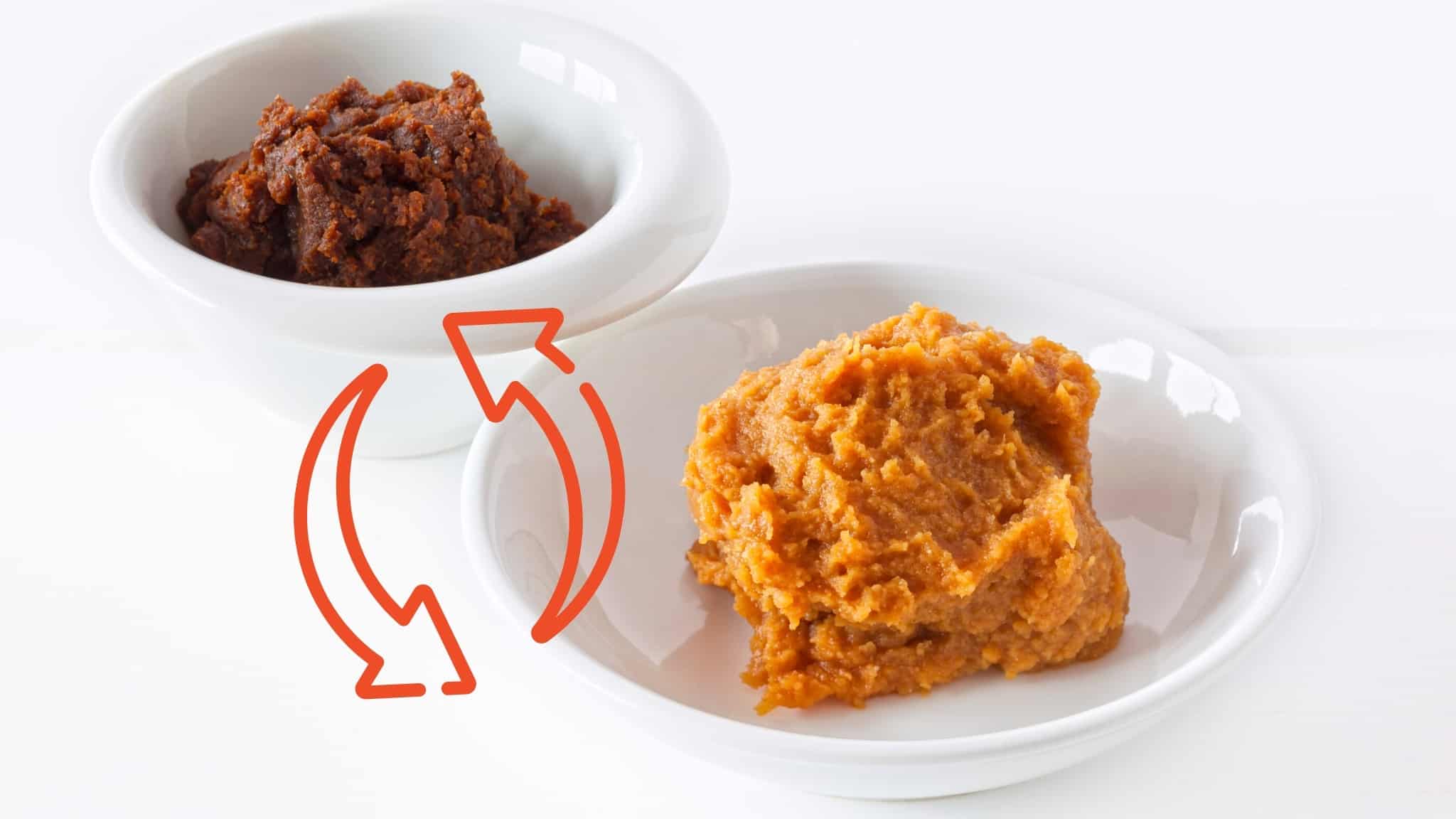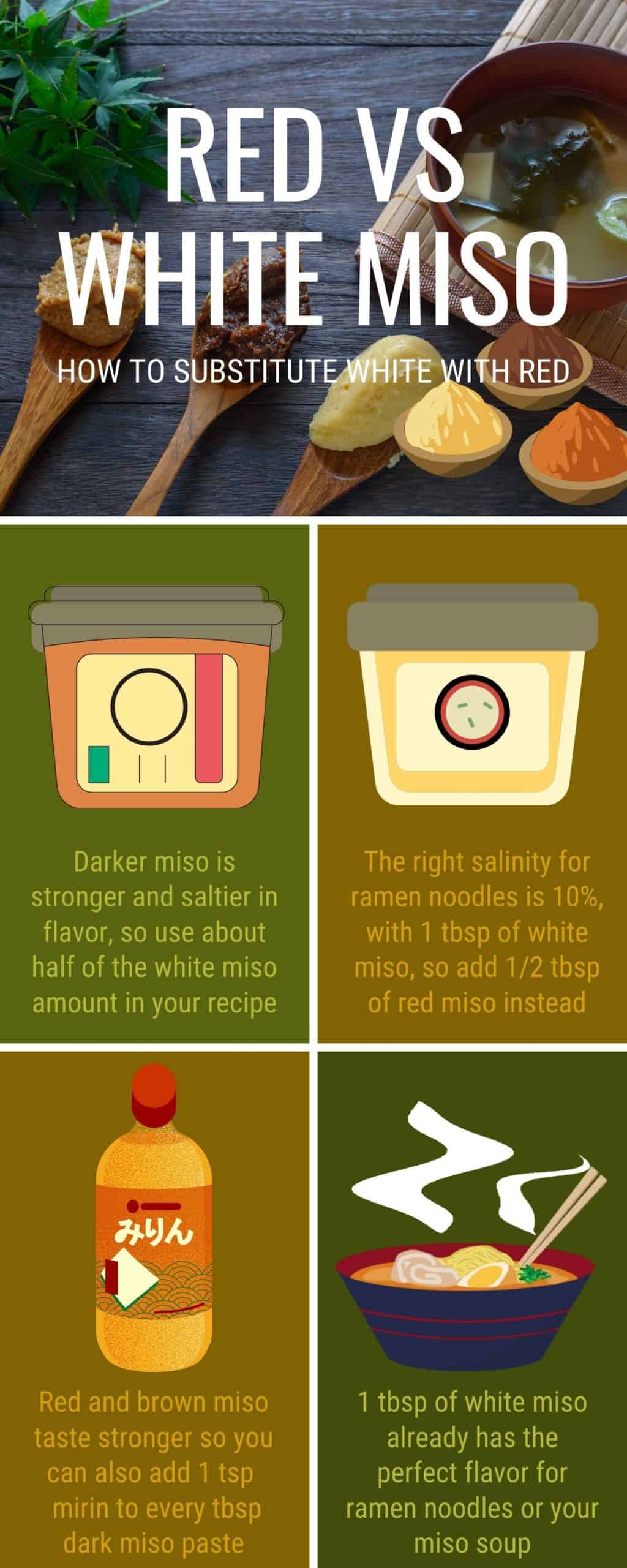Can I use red or brown instead of white miso paste? How to substitute
Many Japanese recipes call for a special ingredient called “shiro miso” or white miso. And if you’re making instant miso soup or ramen, you’ll definitely come across this ingredient in the recipe. But does it HAVE to be white miso paste?
You can substitute white miso with red or brown miso because they’re similar in texture and flavor, and they’re both fermented miso paste. But the darker miso is much stronger and saltier, so use about half of the darker paste where your recipe calls for white.
Maybe you’ve found the red or brown variety at the grocery shop. You’re probably wondering: can use that instead? Let’s look at the exact differences and how to mitigate those.

You can also add a teaspoon of mirin or sugar to sweeten the darker paste and make it milder. That way, you’ll get the same flavor as if you use white miso.
Red or brown miso has a strong taste, and it’s often too different and salty to use the same amount, so you have to sweeten it if you don’t want to alter the food’s flavor too much.
White miso is most often used in light soups, salad dressings, and as a glaze for vegetables. It has a slightly chunky texture, but you can use it for all types of recipes.
Substituting white for darker miso will obviously change the appearance of those dishes as well, but there’s no reason not to try the red or brown variety too!


Check out our new cookbook
Bitemybun's family recipes with complete meal planner and recipe guide.
Try it out for free with Kindle Unlimited:
Read for freeIn this post we'll cover:
- 1 How can you substitute red miso instead of white?
- 2 How to use red or brown miso instead of white
- 3 What is red or brown miso?
- 4 What’s the difference between red, white, and brown miso?
- 5 Do red and white miso taste the same?
- 6 Is red or white miso healthier?
- 7 What kind of miso paste should I buy for the most versatility?
- 8 Get that delicious miso taste, even if you don’t have white miso paste
How can you substitute red miso instead of white?
Recipes that call for white miso don’t require a strong, pungent miso flavor, so be careful not to overpower your food’s flavor with red miso.
You’re likely asking: Should you change the amount of miso in the recipe?
But first, check out this video about the differences between red and white miso:
How to use red or brown miso instead of white
Instructions
- Whenever you add 1 tbsp for red or brown miso, add 1 tsp of mirin (sweet Japanese rice wine) or 1 tsp of white sugar.
- You can also add less red miso and just change the amount. Add 1/2 tbsp of miso for every tbsp of white miso instead.
As a general rule, if your recipe calls for 1 tablespoon of white miso, use 1/2 a tablespoon of red or brown miso or add 1 teaspoon of mirin to 1 tablespoon of red miso for the sweetness.
If you want to keep the exact salinity of white miso in your ramen, then there’s something you should keep in mind. The ideal miso soup has a salinity of 10%, which is the salinity level of adding white miso.
In ramen soup, it’s common to add 1 tablespoon of white miso. So to keep it just as salty, mix ½ tablespoon of red or brown miso instead.
Red and brown miso both have a similar salinity and flavor, so you can use them interchangeably.
This doesn’t alter the soup’s flavor so much as it just makes it milder. Besides the color, you likely won’t even notice a big difference.
What is red or brown miso?
In Japanese, red miso is called aka miso, and it has a dark red or brownish color.
When they make red miso, they let the soybeans and barley ferment for a longer period of up to 3 years. So this type of miso takes on a more pungent and stronger flavor. It’s much saltier than white miso.
Red miso is used in various hearty dishes such as soups, stews, glazes, and marinades. But since it has a strong taste, it can overwhelm mild dishes.
The best time to use red miso is when the recipe calls for dark miso.
What’s the difference between red, white, and brown miso?
As I stated earlier, the red and brown miso varieties are more pungent and saltier because they ferment for a lot longer. White miso is less salty and it has a sweet mild taste.
Another difference is that white miso is made by fermenting soybeans with koji and a large quantity of rice. Red and brown miso, on the other hand, are made by fermenting soybeans with barley, and it takes on a dark color.
When you cook with red miso, it makes your dish turn brown, but the taste is still great. Using white miso makes it turn a light yellow color, similar to what you get when you add milk.
Read more about the different types of miso? [full guide to miso]
Do red and white miso taste the same?
Since you want to substitute white miso with red or brown, you should know that there’s a difference in flavor.
While all have a similar fermented food taste, the darker miso types are much more salty and potent, and they have an earthy, umami flavor.
White miso has a light, mellow flavor, which is slightly salty and a bit sweet.
Is red or white miso healthier?
All miso varieties are healthy because they’re fermented foods.
Miso is packed with protein and since it’s fermented, it’s full of enzymes and beneficial bacteria (probiotics) that improve and aid digestion. Miso is also a source of copper, zinc, vitamin B, and vitamin K.
In terms of carbohydrate content, red miso has more carbs while white miso is low-carb.
The one key fact to note is that red miso is saltier than white, so if you can’t have salty foods, suffer from diabetes or other illnesses, be careful about dark miso’s high sodium content.
All 3 types of miso are healthy and the truth is, there’s not much information as to which is healthiest, since they all provide the same health benefits (albeit with different saltiness).
So ultimately, it comes down to your flavor preferences!
What kind of miso paste should I buy for the most versatility?
When you have white miso on hand, you can use it for all dishes, but you might have to increase the quantity if you want the most umami and salty flavors.
If you want to have to most versatile miso that you can use for all dishes, try awase miso, which is a mix of red and white. It’s a great miso because it combines the best of both, so you still have that rich flavor of the red miso and a hint of sweetness from the white.
If you want to make it taste more like white, use less, and if you want it to be strong, use more.
Awase miso is excellent for miso soup and as a glaze for ribs and fish.
Get that delicious miso taste, even if you don’t have white miso paste
The next time you’re in search of flavorful miso but don’t have white, you won’t have to worry. If you’ve got red or brown miso, you can definitely use them as substitutes!
Related: Miso powder vs. miso paste | When and how to use each
Check out our new cookbook
Bitemybun's family recipes with complete meal planner and recipe guide.
Try it out for free with Kindle Unlimited:
Read for freeJoost Nusselder, the founder of Bite My Bun is a content marketer, dad and loves trying out new food with Japanese food at the heart of his passion, and together with his team he's been creating in-depth blog articles since 2016 to help loyal readers with recipes and cooking tips.

